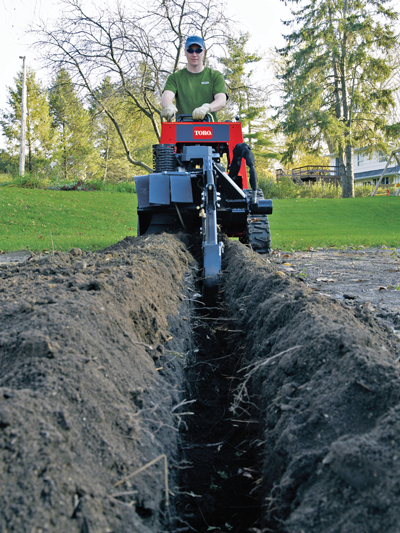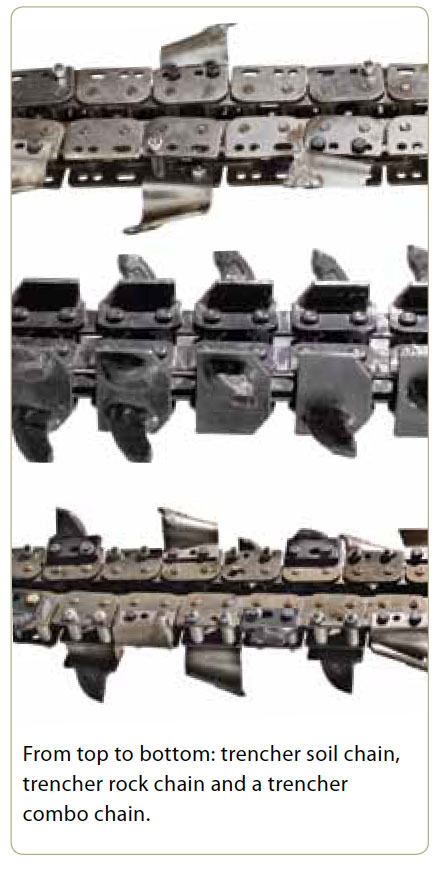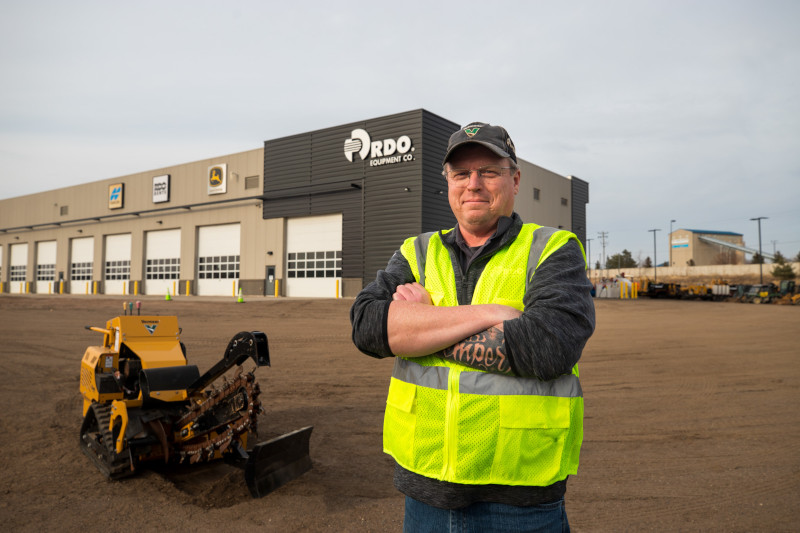Chain Reactions
 Today’s walk-behind trenchers feature easy-to-use controls, tracks for better flotation and increased travel speeds. Those innovations certainly help a contractor out, but the trencher chain remains one of the most critical components in productivity. Having the right configuration can reduce the amount of time it takes to dig a trench, as well as creates less wear and tear on the machine and operator.
Today’s walk-behind trenchers feature easy-to-use controls, tracks for better flotation and increased travel speeds. Those innovations certainly help a contractor out, but the trencher chain remains one of the most critical components in productivity. Having the right configuration can reduce the amount of time it takes to dig a trench, as well as creates less wear and tear on the machine and operator.
The first step to determine if you have the right chain configuration is to make yourself familiar with the various soil conditions in the area. Since most walk-behind trenchers are outfitted with a 2-, 3- or 4-ft boom, you don’t have to concern yourself with the soil conditions beyond those depths. In addition to the tooth configuration, you also need to look at what you’re installing in the trench to determine the width you need to dig. Chain configurations usually come standard in 4- and 6-in. trenching widths, with the option to configure some to 8-in. widths. Remember that every additional 2 in. in trenching width equals around 50 percent more soil that needs to be moved. More dirt means taking more time, so don’t dig a wider trench than what you need.
Pitch: What It Is and Why You Should Care?
When you’re shopping for the right trencher chain, you’ll hear the term “pitch” used by manufacturers and dealers. Walk-behind trencher chains typically come in two- and four-pitch configurations. If a chain is a two-pitch design, it means a tooth can be mounted every second link. If it’s a four-pitch design, it means there will be a tooth every fourth link. The reason pitch is important is if you’re operating in wet or soft soil conditions, you’ll want more pitch (space) between teeth so there is less chance of material sticking. You’ll want the trencher teeth closer together when you’re digging in sandy or harder soil conditions to increase the volume of material you’re moving at once.

There are dozens of different chain configuration options for contractors to choose from. Here’s a rundown of the industry’s most popular ones. The most basic and economic configurations are soil chains (often called cup chains). The teeth can be configured in a two- or four-pitch pattern. If you’re trenching in heavy/wet, sandy or loose dirt, the soil configuration should be able to handle the job. The teeth act as shovels and simply remove the dirt from the trench.
On the other end of the spectrum, rock or shark chains are designed to cut through tougher soil conditions, tree roots and chip away at rocks. Don’t let the name rock chain fool you though — these chains will not be productive in extremely rocky conditions. Most rock chains come with welded carbide tip teeth that last a long time. The reason why you wouldn’t simply use this chain configuration in place of the soil chain is because it usually costs more and doesn’t move as much material.
In between the rock and soil configurations is the rock and soil combination chain. This particular option tends to be the most popular choice for contractors around the country. It’s a nice balance of having the cutting force of the rock chain with the digging productivity of the soil chain. The pattern of these chains combines rock and soil teeth and is higher priced because the teeth are usually bolted on instead of welded on like most rock chains. The combination chain performs well in medium to hard soil, but will also do a decent job in loose or rocky conditions.
For extreme conditions like rock or frozen grounds, you’ll want to step up to bullet or alligator chains. The carbide tipped bullet-shaped tooth is the same material used on rock augers and mining equipment. They are more expensive, but are easily replaced and can handle chipping away at really challenging soil conditions. Keep in mind, when you’re working in extreme conditions, the job is going to take longer. This chain configuration does not move large volumes of material through the trencher quickly.
Getting the Most Life from Your Chain
Teeth Maintenance — Most tooth styles include carbide inserts on their sides, tops or faces. When this carbide is dull or worn away, the tooth needs to be replaced. It is important to pay close attention to the condition of your trencher teeth and replace them when necessary to promote efficient digging. One important thing to note is that there are left-hand and right-hand teeth. When remounting the teeth, some should be mounted so the cutting edge is angled away from the chain and some should be angled toward the center of the chain. To accomplish this, mount left-hand teeth on the right side of the chain. The tooth’s cutting edge should be toward the center of the chain. This will break up and remove dirt the full width of the trench.
Chain Maintenance — When adding teeth or widening a chain, the teeth and spacers need to be placed equally apart on the chain to ensure the trencher is digging through the dirt efficiently and that there is a steady hydraulic load on the trencher and traction unit. Chains and sprockets are designed to work together and, therefore, should be replaced at the same time to avoid premature wear of either part.
Sean O’Halloran is a marketing product manager at The Toro Co., based in Bloomington, Minn.



